The new yellow in Sierra Leone: Getting Ebola to Zero
A year on from the Ebola outbreak, a new campaign with journalists, students and teachers is injecting fresh energy into the drive to kick Ebola out of Sierra Leone.Date:
While celebrating as the World Health Organization declared Liberia Ebola-free on 9 May, neighbouring Sierra Leoneans are still struggling to put an end to Ebola in their country. Seeing the crucial front-line roles women play as caregivers, and also for the current crisis since the onset of the virus in the country in May 2014, UN Women partnered with UNMEER (United Nations Mission for Ebola Emergency Response), to support the women of Sierra Leone in leading the new “Getting Ebola to Zero and Staying Zero” campaign launched on 2 May 2015.
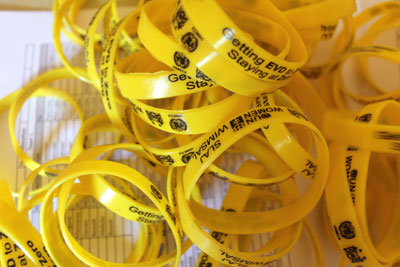
The nationwide yellow movement aims to inject fresh energy and drive into stamping Ebola out of Sierra Leone. With yellow seen as a colour representing hope and strength, Fridays have been set aside specifically for supporters to wear yellow and raise awareness. The campaign encourages women as caregivers in particular to make pledges to adopt various measures to end the spread of the disease and keep it at zero.
“I have promised myself not to keep silent anymore,” said Adama Sesay, a volunteer at one of the community engagements in the hotspot District of Kambia. “I will be more vigilant, I will inform the chiefdom authorities of any stranger in our community and I will call 117 (the Ebola emergency hotline) if I suspect any case of Ebola.”
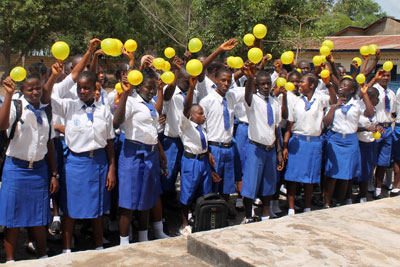
Two weeks after the launch of the campaign, primary and secondary schools across the nation are also embarking on various Ebola knowledge-sharing activities. Schools are now organizing “Yellow Days”, Ebola Awareness Days, as opportunities for key national Ebola actors from the National Ebola Response Centre, UNMEER and World Health Organization to interact with students and their teachers as they talk about the Ebola virus disease.
“I wear YELLOW because I love my country,” says Madi Kamara, a 5-year-old of Kossoh Town Primary School in one of the hardest-hit Ebola Western Area rural regions of Sierra Leone. Madi is particularly excited today because she, and all the other pupils and teachers, were not in their regular school uniform but in yellow outfits.
Parents are encouraged to become active monitors of the schools premises, rendering support where feasible to ensure the school grounds stay Ebola-free. Madi’s mother helps take the temperature of the children as they cue up for assembly and his father is trying to get out-of-school youth to provide water to the school for the children to wash their hands regularly – one major strategy for keeping Ebola away.
The “Getting Ebola to Zero and Staying Zero” campaign is built on the foundation of the the on-going Sierra Leone Association of Journalists (SLAJ)’s Yellow Ribbon Ebola campaign that was launched earlier in March, but this time with women taking the lead, and more focus on community, youth, religious and traditional leaders.
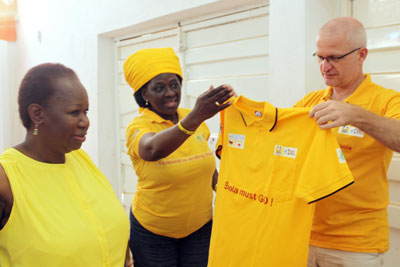
“We want to highlight the need for women to be understood and seen as catalytic stakeholders and agents of change which makes them well-suited to lead the way in driving Ebola out of Sierra Leone,” said Mary Okumu, UN Women Representative in Sierra Leone, at the formal launch of the campaign on 2 May at the Radisson Blu Hotel in Freetown.
The Deputy Minister of Social Welfare, Gender and Children’s Affairs, Mustapha Bai Attilah, welcomed the added value that the women were bringing into the campaign which he says “now illuminates the path and makes way for a speedy eradication of the disease.”
Targeting media
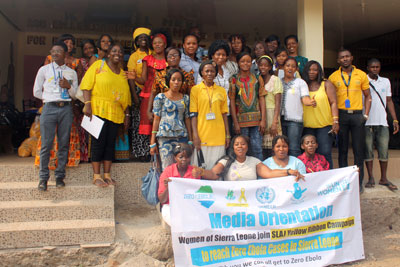
During the week of 27 April 2015, UN Women and UNMEER conducted various workshops at regional levels for 125 female journalists to equip and position them to understand the gender dimensions of Ebola, in order to help them articulate the objectives of the campaign. Together, they designed messages based on local contexts with input from the women of Sierra Leone. The messages aim to enhance community understanding of the Government of Sierra Leone’s prescribed Ebola Virus Disease (EVD) prevention methods. On Sierra Leone’s Independence Day, 27 April 2015, the journalists broadcasted a nationwide panel discussion of women who shared their experiences on how Ebola had affected them.
“I really do think that if women had understood the prevention messages well, Ebola would not have reached this height in our country,” said Ndeamoh Mansaray, of Cotton Tree News, adding that she was “embarrassed” that she had not been quicker to recognize the “many and obvious ways” in which women and girls are also more vulnerable.
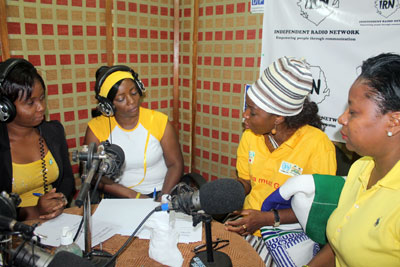
According to the National Ebola Response Centre, as of 17 May 2015, cumulative confirmed cases are 8,603 in Sierra Leone, which include 3,540 confirmed deaths, and 3,571 survived and discharged cases. A country is considered to be free of Ebola virus transmission when 42 days (double the 21-day incubation period of the Ebola virus) has elapsed since the last patient in isolation became laboratory negative for the virus.
The Sierra Leone Government’s post-Ebola priorities will focus on health, education, social protection and economic recovery.
The Getting Ebola to Zero and Staying Zero campaign is funded by the Governments of Germany and Japan.